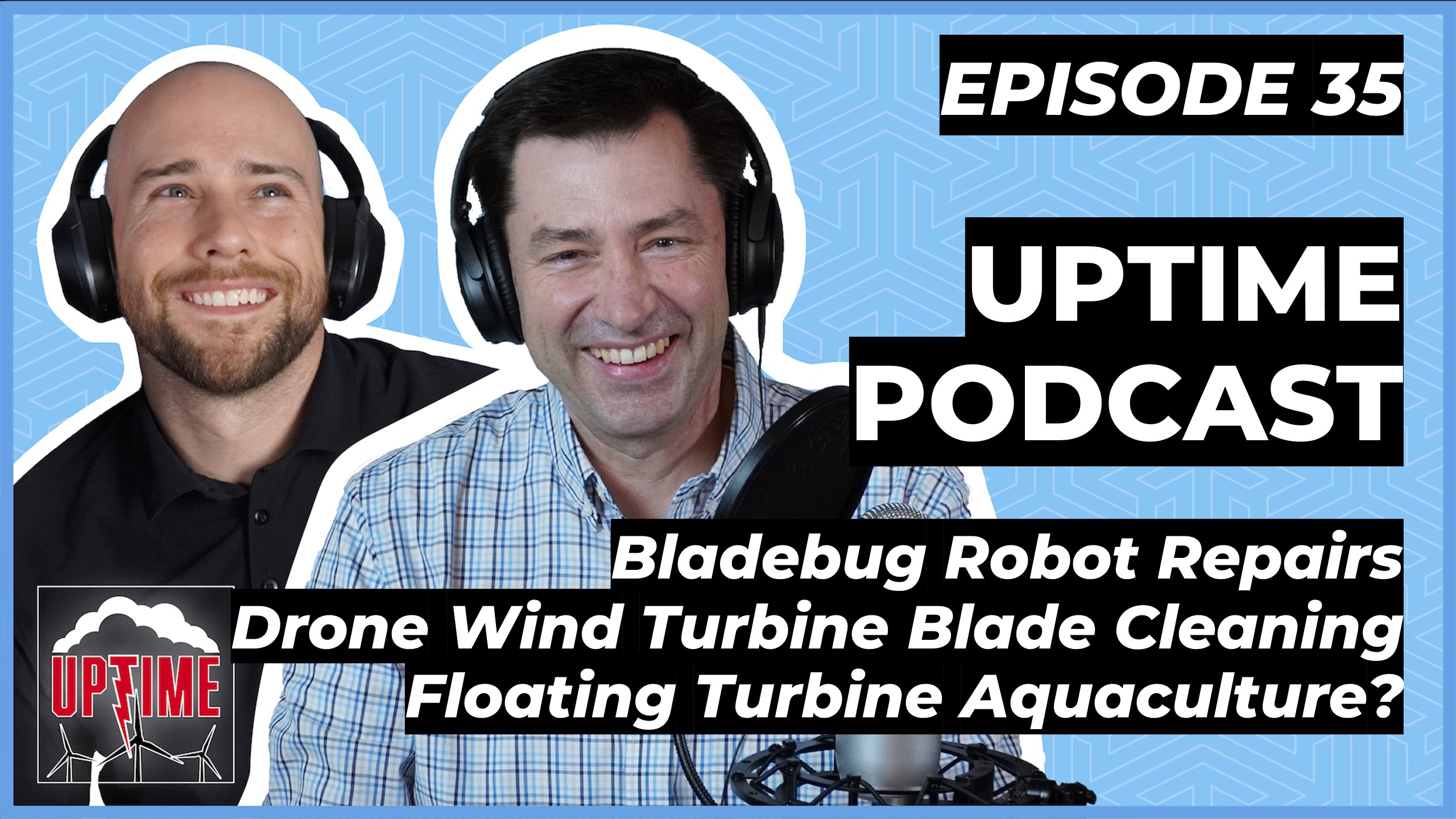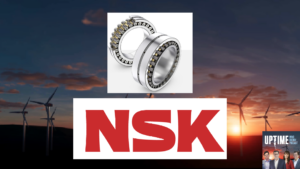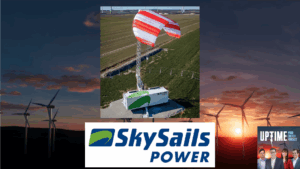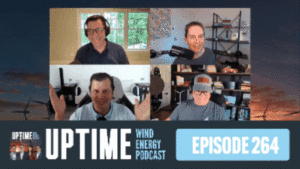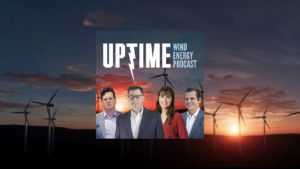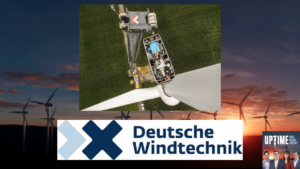In this episode of the uptime wind energy podcast, we discuss robotic technology by Bladebug, drone blade cleaning by Aerones, floating wind aquaculture and more. Can we really build a fishery or lab on a floating wind turbine? Maybe…
Learn more about Weather Guard Lightning Tech’s StrikeTape Wind Turbine LPS retrofit. Follow the show on YouTube, Twitter, Linkedin and visit Weather Guard on the web. Have a question we can answer on the show? Email us!
Podcast: Play in new window | Download
EP35 – BladeBug Robotic Tech, Wind Turbine Blade Cleaning & Floating Wind Turbine Aquaculture Labs?
this episode is brought to you by weatherguard lightning tech at weatherguard we make wind turbine lightning protection easy if you’re a wind farm operator stop settling for damaged turbine blades and constant downtime get your uptime back with our strike tape lightning protection system learn more in today’s show notes or visit weatherguardwind.com striketape
welcome back i’m allen hall i’m Dan Blewett and this is the uptime podcast where we talk about wind energy engineering lightning protection and ways to keep your wind turbines running all right welcome back this is the uptime podcast i’m your co-host Dan Blewett on today’s episode we’ve got six main topics first off we’re gonna chat about Siemens Gamesa potentially uh making a pretty big loss here with uh having to replace faulty gearboxes we’re going to chat about an interesting multi-use project for potentially floating offshore wind turbine platforms so i think this is sort of a natural progression so we’ll chat about some of the ways aquaculture might come to floating wind we’re going to talk about a little bit of lightning news where ai is getting closer to predicting predicting where lightning will strike in advance which is crazy we’re going to talk about elf so some electric magnetic stuff as far as bearings and gearboxes we’re going to chat about robotic uh blade critters the blade bug pretty interesting technology crawling up wind turbine blades and doing some inspections uh repairs and then we’re going to talk about cleaning which is something that i don’t think it’s enough press when it comes to not only wood turbines just in general but also the lightning effects as well talking about that so Allen let’s start here with Siemens Gamesa so it looks like they’ve lost uh 70 million euros uh article from energy watch on faulty gearboxes ouch that’s a yeah right yeah gearboxes you know you see that well Siemens Gamesa is now pushing the their how many is it 14 megawatt direct drive 14 dds right okay so yeah so the gearboxes uh are just a failure point which is why the direct drive starts to make a little more sense the the issue with gearboxes is there’s vibration components there’s that can happen uh obviously lubrication is a big deal uh any sort of material failure metal failure inside of those things can be a problem so it’s just not not a huge news point but i think it sounds like they have some cracks in the case which are i guess probably fatigue related um or material related and they got a material issue with the casting that they didn’t expect and you know what are you going to do besides replace them there’s really nothing to do about it because once you start there’s a there’s one thing if you can get inside and start taking out different parts of the gearbox and replacing them but if you start cracking the case it’s like the uh cracking the block on a internal combustion engine it’s pretty much over there’s not a lot nothing to do about that you can’t weld it back up that’s just not a thing so uh this is a big problem and i think they found it from what i could read they found it actually on their test bed first which is where you want to find those things uh before you start seeing yeah prototype yeah which is where you want to find them right you want to try to this this is a very common engineering thing to do is you can’t run the your piece of equipment out for 20 years and then sell it because then no one will want it because it’s 20 year old technology so what you do is you get out a year or two in front with the technology and you have it running and operating and then you can detect those likely failure modes and then pass that along to your customers say hey these these little repairs or mods you need to get made to keep it up and running and then that’s that’s part of the expected part of the deal but when you have sort of a significant catastrophe and it’s not catastrophic but it could turn into catastrophic if you left unattended you want to fix that up front and in this particular case it’s a main component of the the turbine so ouch um it’s a problem it’s a big problem yeah absolutely of course for a huge company like you know siemens mesa 70 million seems like a lot but probably just a little drop in the bucket for them and obviously a lot better than maybe getting out of hand and being a much bigger problem than that oh sure because they said they they don’t expect for it to be much more than the 70 million that’s already already been spent on repairs and replacement yeah so right because you can envision the kind of failure modes it could get into from just leaking oil to gear failure to overheating conditions which are all bad so it’s it’s really it’s really great you know that the the wind turbine companies when they develop these products are looking a couple years out in the future which is what they should be doing so hats off even though the outcome is not great at least hats off you know you’re making the industry safer by doing that well yeah and these events in business are newsworthy because you know big loss people want to know you know on the investment side and all that stuff but you know like every business and even person like you know a person gets x amount of parking tickets a year right or speeding tickets or you know your car gets you know vandalized or you know a tree falls on it like there’s just so much amount of loss that you have in your regular life remember apple a couple years ago tried to invest in that huge sapphire manufacturing plant lost like a billion dollars it just didn’t work yeah you know and apple just kept chugging right along so you know i’m sure they all these companies have these sort of like built in like you just know you’re gonna stub your toe as a person as a business like x amount of times throughout the year and you just you know chalk it up to trying and just keep moving forward i guess right yes but speaking of innovation uh this is a cool thing i think this is a really interesting idea offshore wind with an aquaculture facility built in so they could potentially grow you know shellfish or do all sorts of projects depending on the climate you know where they are in the world but with these offshore floating platforms i think that seems like a pretty natural progression so in this article by renews.biz just talking about the uh opex the offshore platform for energy competitiveness they’re setting up a 15-month feasibility project to see you know can we sort of combine and make this like an aquaculture lab in addition to obviously being a functioning floating wind turbine how do you feel about this mr engineer uh the dual use makes a lot of sense because it’s an existing piece of hardware that’s out there and you can adapt it do more with it yeah it does the only thing that worries the engineer part of it is will the extra events that are happening on your platform somehow degrade the uh performance of the platform somehow like it would cause additional corrosion would the shellfish attaching themselves to these pylons essentially cause issues going forward from so from the engineering standpoint you’re like i don’t really like anybody messing with my design i know what it is i know if it’s left alone fine right and when you start putting extra things on it especially have to do with the wildlife it just adds that level of i’m not sure this is a great idea but it does it does lend itself into looking at it and and it needs to be developed before it gets instituted in a larger scale but there are opportunities there right i think there are real opportunities there because you have this really fixed platform and and if you can grow shelf shellfish off of it and it just makes life easier to do that then great and i think there’s some other opportunities there too because you got this flick fixed platform you could instrument it to monitor ocean temperatures waves you can monitor um the area with cameras for whatever reason first ships coming in and out or if you’re on the in places where there’s a lot of uh nefarious traffic coming in and out you could actually load these up with sensors and that kind of thing so there’s a lot of opportunities to make it a dual use it’s just uh engineering-wise you just never never want your little baby to be altered right so i think there’s probably a little bit of hesitation there yeah one also would make this thing from essentially an uninhabited thing in the ocean too and inhabited like if there’s going to be aquaculture there’s going to be people there and if this is going to be x amount of miles offshore or just even a couple thousand yards offshore which i’m sure it’s going to be farther than that now like people have to live there some amount of time you have to have some sort of accommodations probably like if there’s a research lab people can’t just be going back and forth five hours by boat it’s not gonna be make any sense from a time efficiency standpoint so then it’s like okay well now there’s people living here for two weeks at a time or a month at a time how does that change the noise the turbine can make and all these other different things like now there’s just like it becomes probably becomes really complex really fast it’s my guess too sure it does and there’s always kinds of insurance issues about being on the platforms and right you can take your take your boat and equipment up to the platform but once you cross onto the platform you’re at a different level of restrictions and training rights so it does have a little difficulty and as soon as you put humans on anything uh from the design standpoint there’s added risks like people do inadvertent things that can cause problems so usually usually alan i gotta stop you this is this is the way we combine the podcasts into so here’s hear me out here you got the floating offshore wind farm that makes the world’s finest oysters whatever then we get the evtol market which we talk about in the struck podcast and you have these evtols come in to grab the day’s you know harvest take them back to shore so now you’re combining wind power with evtol you know electric off vertical vertical takeoff and landing it’s uh everything’s coming coming together see i think this answers the the other problem which is in order to get to some of these offshore sites you need to be on a boat for a while and yeah right now the only answer right now is helicopters that’s the only faster way to get back and forth but they cost so much to operate you’re going to see electric uh aircraft going back and forth to these to these platforms that is inevitable that’s coming and yeah it does change the dynamic quite a bit because then you don’t have to be on site all the time because the cost of getting to and from just went way down way way down and yeah you could have fresh seafood you could have fresh selfish coming to your dinner plate from turbines it’s possible it’s very very possible there you go so last thing on a new segment here uh ai can potentially predict where lightning will strike 30 minutes in advance so Allen you’re the lightning guy take us take us through this is this real or is this oh sure this guy no it’s not pie in the sky but uh when i read the article i had to take a double take because what pieces of information are you using to determine where lightning will strike and is it just looking up at the sky and saying yeah there’s a thunderstorm cloud because that’s usually your your first indicator like wow that’s a really tall cloud and it looks awful dark and those kind of clouds generate lightning and they generate lightning tends to be on the on the front end it gets it depends honestly but there you can if you know there’s a cloud there you generally know where the lightning is going to come out of that cloud and there’s also like a rate that you know because it takes a certain amount of time after a discharge or a lightning flash that that uh it takes for the cloud to kind of charge back up again and then do it again so there’s sort of a repetitive nature to these things so you could you do that oh and create a artificial intelligence algorithm to help predict that yes you could but do you really need one i’m not i wasn’t sure what the need was here like we know that lightning is going to strike but i can use my eyeballs to do that too what added feature is there to it because how are you going to use the data uh unless unless you’re using the data to protect like stadiums of people or uh soccer fields or football as it’s called in most part of the world uh you don’t want people out on the on the on the field getting hurt by lightning strikes is that where that was going i assume that was part of it well i mean is there any any way to protect things from lightning so if we know it’s going to strike in this given area like do we like shoot like a something over to like you know like in in movies you like dive in front of the bullet to protect someone else like is there any what’s the application can we fire something off to take the lightning strike like i mean yeah well practical example you were talking about the spaceship the space shuttle right like they figured out in the 60s that the space shuttle would actually cause lightning strikes so to prevent that they would fire off was a little ballistic was it missiles or was it lasers lasers right well they have they have these they have these rocket launch systems which are they still do down in florida at the university of florida that have very thin copper wires behind them so they’re essentially model rockets they have very fine copper wires and they fire them off and they’ll actually trigger lightning events so it’s a way to discharge the cloud so to speak so yeah you could do some something like that i think the other the one that that keeps getting popped up year after year after year which hasn’t really been implemented widely yet is lasers to discharge the cloud to basically create a lightning event and discharge it before it got to something you cared about like a wind turbine but we really haven’t seen much of that and there’s really there is some randomness to lightning that’s part of its uh allure is that it just happens randomly that’s what we call it force measure a lot of times because it is sort of this random event and i don’t know if you’re ever going to take the randomness out of it you may be able to detect where it’s likely to occur but the randomness part is still still there
all right so in our second segment here we’re going to start off with elf so alan you’re an electrical engineer uh you know we’re talking about electrical line frequency and some of the issues that this can have so interesting article out of windpowerengineering.com by david clarke of cms wind he says about 50 of drivetrain failures are in the generator and some of this can be stray electrical current so what does electrical line frequency what can that do to a wind turbine why is that a problem in the generator itself there can be stray currents running around inside and it depends upon the way that the generator has been designed uh but essentially it goes like this so you’ve got this these machine that is rotating through magnetic fields and that creates electricity that’s how you create electricity so you got a rotating magnetic fields and copper wires and loops and that coupling creates electricity but you also have a lot of stray currents or you can’t have a lot of stray currents and those straight currents can create problems if those straight currents go through mechanical pieces particularly rotating mechanical pieces like bearings so anything where you have a very finely machined part that is rotating if you get sparking inside of that because you have stray electrical currents essentially that those little little sparks even though they seem harmless each one as an individual spark is is relatively harmless but as they add up over time and you start to pit the bearings or pit the raceway or pit the bushing those little little pinpricks start to add up into something and over time you start to start grinding away at bearing interfaces and bushing interfaces and the wear and tear explodes and so that you essentially short the lifetime of that generator and the bearing and so you want to be able to have some sense of what’s going on in there and whether uh that event is happening this is why the early generator testing is really important because if you’re looking at lifetimes sometimes it’s some of these events internally to the generators you can’t really see all that well detect all that well but you see them in other ways and the way that describe the article is hey this you start to see vibration because that bearing isn’t as smooth as it once was when it was factory new all of a sudden you’ve got this grinding surface coming together and it’ll eventually destroy itself given enough time and you don’t want that so you want to try to control those stray electrical currents as much as you can or quote unquote ground them out so you don’t have them running through through the bearings in the raceways and all that kind of stuff and so from a risk mitigation standpoint uh early development testing and all the monitoring that happens at the oems it plays a big part into eliminating that but it sounds like there’s either things that have changed or design has changed and then that’s getting in service and if you’re seeing that in service it’s a big big issue if you’re seeing it especially if you see any vibration data for your generator that’s a problem that’s a really big problem so moving on the uh this is a really interesting thing uh the blade bug so they’ve done some testing and this is a a robot that will walk on a wind turbine blade even in its vertical position uh it’s and they have it looks like a couple different configurations but the one they’ve uh sort of tested recently looks like it has i think six or eight feet depending um but it’s uh just picking them up and putting them down just with little suction cups and it uses vacuum to walk on this blade and obviously the potential here this has not been tested on a live wind turbine yet not like moving but in the field you know out at sea potentially yeah um but obviously like you know the future you know danielle’s from sky specs talked about obviously the imperative um use of drones and how important they are but also he was talking about potentially robots you know clinging to blades and and walking up and down and doing repairs he was kind of mentioning this sort of concept before and uh to me these seem it seems really slow obviously this is a prototype this is like the first phase of this getting somewhere right like we need this to start somewhere which is which is great um but it seems like just looking at the design which is fascinating but it seems like it’s a long way from this thing having different tools and actually grinding into a blade or making repair doing this doing that it seems like that’s pretty sophisticated on top of just the fact that you know this is a really sophisticated device just to walk on the darn thing right am i wrong here you know you’re right even to walk on it if you think about it’s impressive it’s really impressive yeah yeah and blades aren’t the cleanest thing in the world so if you’re trying to simply grab hold or suction cup your way up a blade the the surface contours and all that make it a little more difficult so just to stick to the side of the blade is impressive and then to move along and not fall off which is also not easy because especially the wind’s blowing i mean there’s a lot of forces going on there that would want to eject your little robot are these is it windy is it windy where they put these uh these machines occasionally it is yeah so it tends to be yeah it has to be a little windy and also in places where it’s wet right and in places where it’s cold and places where extremely hot so you’re putting this robot in the really rough environment and saying i’m going to take in fact all these variables and i’m going to not fall off which is which is remarkable and even to attempt it is i think difficult to conceive because yeah it’s for sure it’s just way too many variables of of are you always attached and you ever seen the you probably don’t watch these movies but you ever seen the mission impossible movie where tom cruise’s suction cupped his way up the side of the skyscraper uh with the little gloves actually gloves the gloves that stick to the side of the building and adding suction cups is these suction cups gloves i think i’ve watched at least one of the mission impossibles not like a like they weren’t like on my list but i i know james bond has done that at different points right like everything has done that is like old news for spies come on so what always happens at all those movies right the suction cup gives way and they then your hero follows chaos which is the first thing you think about any sort of suction cup device is like is like oh it’s only going to work most of the way and then something tragic is going to happen in the story story unfolds from there so yeah it’s an uphill battle so even if you get the technology right i think um just the perception of the technologies it’s gonna make it a little bit difficult to gain traction but if it works it works and that’s what it comes down to if it works and can show that it saves somebody from being on that blade for a long period of time it will be adopted it will be adopted yeah well and i was wondering out loud well not out loud but internally how does this thing get up there well it looks like they you know go up tower traditionally on top of the nacelle and then all right go a little doggy and they’re just starts marching down the blade um but obviously like you know way down the road maybe there’s a drone that lifts it up into place and just shoves it right where it needs to go that’s probably obviously the ideal right to have humans on the ground right although i guess going up the you know traditionally through the center of the tower not a big deal it’s not a big deal either no so um but obviously you know if these are offshore platforms the best scenario would be one dude just goes out there with all the equipment and just like push a button which is you know what sky specs drones and other drone companies do and just push a button and it does its thing you know one drone goes inspects the blade and then it comes back down and picks up the the bug and takes up to the spot and then it does it’s like they’re on their own little team essentially right yeah the guy tells the drone what to do the drone makes a plan and then the drone takes the the construction crew up there which is just the robots see this this is so popular mechanics and i don’t know if you ever back in the back in the day the 70s and 80s and popular mechanics would have a lot of articles about robots and technology and you’re like ah that’ll never happen it kind of put it in the in the realm of flying cars but now we’re getting close to flying cars so now it’s time for the robots to come in too so all this is going to happen in the next i think really realistically in serious applications in the next 10 years it’s going to be we’re going to be talking 10 years from now going yeah that happens all the time it just does yeah and at some point the drone probably just flies up and then you know it sprouts its feet just like an airplane you know puts its landing gear down and it just hovers closer and sticks to it yeah that’s that it’s all just one integrated thing yeah and then just when it’s done it just takes back off flies off the off the blade and comes on down yeah so it’s going to be that easy and yeah it’s eventually yeah that’s a lot of complexity to to get to that point plus battery life that’s the other thing it’s a lot of energy to get up there hover do all this stuff and then come back down yeah but we have self-driving electric vehicles and if we can do that then we can put robots on turbine blades no sweat that’s just a matter of time
so last topic today uh drone well not just drone but wind turbine cleaning so i don’t think a lot of people think about this obviously they’re these big shiny white things but Allen they don’t really stay shiny white that long do they no very little so somebody’s cleaning these gigantic machines uh you see the the videos and uh linkedin uh bits from Aerones which has uh uh it’s a very fascinating company i don’t want to get into a 2d but essentially they have a sort of a rope based system they got four ropes that can lift uh it’s not a robot but a mechanism i’d call it up and down the wind turn blades but they also have an ability to to clean them because they can manipulate up and down along the blades uh a cleaning robot so to speak um which in the videos was fascinating because you don’t realize how dirty the blades get unless you’ve been around them enough to know like they’re dirty and they’re anything of any kind of dust particle smoke uh debris that’s in the air is getting on those blades and one is creating uh a little bit of turbulence and drag so it’s not as smooth as it once was and and two from the sort of the lightning perspective all that debris and dust and particles and whatever else is attached to it makes the blade shell slightly conductive and and all those little and especially if it’s if it’s salt uh from the ocean and there’s there’s salt in pretty much any bit of air you’re going to get that on the blade and all sudden your lightning protection system doesn’t work like it you think that it should and we get pictures all the time of uh wind turbines where there have been lightning strikes that have happened further from the tip meters from the tip five meters seven meters 12 meters from the tip you’re like what is going on there well all the all the debris on the outside of the blade is slightly conductive and what happens is the lightning protection system which is usually a bunch of receptors on the surface when those receptors become energized they just start electrically start reaching out everywhere that’s conductive and so it actually instead of reaching out to the sky it’ll also reach down the blade because that’s a very conductive thing and it’s sort of the last it’s a it’s a path of least resistance so you can either jump out to the sky which is pretty resistive or i can just kind of shoot down the blade just to energize the blade up which is what happens and then bad stuff happens subsequently but uh cleaning the blade minimizes that a good bit and but you rarely see unless there’s been like a smoke or some real contaminant on the blade you really rarely see them cleaned uh but i i think as we get discussing the 20-year lifespan does it make sense to clean them every couple of years if the answer is probably yes depending where you are in the world the answer is probably yes because it keeps the aerodynamics up it should help minimize some of the lightning issues that occurs the blades get dirty right and and just make the performance better and if it doesn’t take that long to do it then why wouldn’t you do it if you’re already inspecting the blades uh with the system which probably you are then while you’re there why are you not cleaning the blades because it doesn’t really cost you anything at that point they’re already there yeah and doing some research there’s a lot of companies that that do this that do wind turbine cleaning some of them go up ropes it just depends but it seems like using drones is becoming more and more of a prevalent thing this video i found by mash, on by mashable on youtube just shows a drone that has a electrical cord actually um and so that allows it to stay in the air indefinitely and and support you know with higher voltage i guess support you know pumping water up there to it so it’s just up there hanging out as long as it needs to just keep pumping up water and just blasting the blade which seems like definitely the most efficient way to do it rather than send people up there because oh sure for all for all for all the hazards being up there if you’re up there with a power washer that seems awful because i mean anyone’s ever power washed anything you’re just getting a ton of spray back in your face you’re getting really wet and uh and being wet with safety equipment and all that high off the ground and it’s windy you know and cold probably yeah that seems so let’s let’s keep going with the drone the drone cleaning that seems like the definite way to go yeah but yeah it’s really interesting i haven’t thought much about it but you know you see a lot of them and they’re pretty pearly white and they definitely can’t stay like that forever you’re right especially in the harsher environments and especially like underneath like underneath the nacelle that’s where there’s you know like the blades are gonna get they’re gonna connect with rain and they’re gonna sort of self-clean too but yeah to an extent i’m sure but underneath the nacelle is where it seems like they get pretty grimy because oil nothing’s
if they’ve had especially have a gearbox let loose or they’ve had some sort of spill which happens right and that just goes right down the tower and then anything it’s sticky you know how well it gets when oil dries out it’s sticky so then you get all this other crud sticking onto the sticky oil you just want to get it off of it because it can also trap water kind of bakes on there after a while not going to be able to get it off very easily salt and debris and stuff gets stuck in it and then it’s sitting against the the tower you don’t want to start a corrosion issue you want to get that stuff off so it makes a lot of sense yeah it’s just one of those things like i said probably one of the things that flies under the radar a little more about these massive machines that does get taken care of sooner or later just probably not you know maybe really often intervals maybe it’s every year two years if you’re out there and you’re listening shoot us a message how often does your wind farm get cleaned let us know all right we’re gonna wrap up today’s episode of uptime if you’re new to the show welcome if you’re a regular here thank you for your continued support please subscribe to the show and leave a review on itunes spotify or wherever you listen to podcasts don’t forget to check out the weather guard lightning tech youtube channel for video episodes full interviews and short clips from each show for Allen and all of us at weather guard stay safe and we’ll see you next week is downtime causing you financial pain and putting a stop to your power production for months on end it’s no secret lightning strike damage is a major cause of wind turbine downtime this damage is preventable with our easy to install strike tape lightning protection system for wind turbine blades our incredible engineering build quality materials and edge sealants withstand up to five times more abuse in the toughest weather and lightning conditions and we’ve got the research to prove it if you’re tired of constant downtime we can help reach out to us at weatherguardwind.com and schedule a free call we’ll get your uptime back in no time



